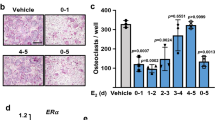Abstract
The decrease in estrogen level that follows the onset ofmenopause causes rapid bone loss, resulting in osteoporosis.However, the mechanism remains unclear, especially concerningthe regulation of bone-resorbing osteoclasts. Here we analyzedthe function of estrogen and its receptor in matureosteoclasts. We found that estrogen directly inhibitedbone-resorption by purified rabbit mature-osteoclasts.Moreover, using a RT-PCR technique, we report that nuclearestrogen receptor (ER) α but not ERβ is expressed in mature osteoclasts. The antisense oligodeoxynucleotide for ERα inhibited the reductionin osteoclastic bone-resorbing activity caused by estrogen. We conclude that in part estrogen directly inhibits the bone-resorbing activity of mature osteoclasts through the ERα.
Similar content being viewed by others
References
Arts J, Kuiper GG, Janssen JM, Gustafsson JA, Lowik JCW, Pols HA and van Leeuwen JP (1997) Differential expression of estrogen receptors alpha and beta mRNA during differentiation of human osteoblast SV-HFO cells. Endocrinology 138: 5067–5070.
Blumberg B and Evans RM (1998) Orphan nuclear receptors-new ligands and new possibilities. Gene Dev. 12: 3149–3155.
Das SK, Taylor JA, Korach KS, Paria BC, Dey SK and Lubahn DB (1997) Estrogenic responses in estrogen receptor-α deficient mice reveal a distinct estrogen signaling pathway. Proc Nat Acad Sci USA 94: 12786–12791.
Hakeda Y and Kumegawa M(1996) The growth and culture of bone cells: Osteoclastic. In: Bilezikian JP, Raisz LG and Rodan GA (eds.) Principles of Bone Biology (pp. 1217–1228) Academic Press, New York.
Hoshino S, Inoue S, Hosoi T, Saito T, Ikegami A, Kaneki M, Ouchi Y and Orimo H (1995) Demonstration of isoforms of the estrogen receptor in the bone tissues and in osteoblastic cells. Calcif Tissue Int 57: 466–468.
Inui T, Ishibashi O, Inaoka T, Origane Y, Kumegawa M, Kokubo T and Yamamura T (1997) Cathepsin K antisense oligodeoxynucleotide inhibits osteoclastic bone resorption. J Biol Chem 272: 8109–8112.
Ishizuka S, Kurihara N, Hakeda Y, Maeda N, Ikeda K, Kumegawa M and Norman AW (1988) 1α, 25-Dihydroxyvitamin D3[1α, 25-(OH)2D3]-26,23-lactone inhibits 1,25-(OH)2D3-mediated fusion of mouse bone marrow mononuclear cell. Endocrinology 123: 781–786.
Kakudo S, Miyazawa K, Kameda T, Mano H, Mori Y, Yuasa T, Nakamaru Y, Shiokawa M, Nagahira K, Tokunaga S, Hakeda Y and Kumegawa M (1996) Isolation of highly riched rabbit osteoclasts from collagen gels: A new assay system for bone resorbing activity of mature osteoclasts. J Bone Miner Metab 14: 129–136.
Kaluz S, Kaluzova M and Flint APF (1997) Sequencing variability in the A/B region of the estrogen receptor. Anim Biotechnol 8: 221–226.
Kameda T, Mano H, Yuasa T, Mori Y, Miyazawa K, Shiokawa M, Nakamaru Y, Hiroi E, Hiura K, Kameda A, Yang NN, Hakeda Y and Kumegawa M (1997) Estrogen inhibits bone resorption by directly inducing apoptosis of the bone-resorbing osteoclasts. J Exp Med 186: 489–495.
Kassem M, Harris SA, Spelsberg TC and Riggs BL (1996) Estrogen inhibits interleukin-6 production and gene expression in a human osteoblastic cell line with high levels of estrogen receptors. J Bone Miner Res 11: 193–199.
Kodama H, Yamasaki A, Nose M, Niida S, Ohgame Y, Abe M, Kumegawa M and Suda T (1991) Congenital osteoclast defi-ciency in osteopetrotic (op/op) mice is cured by injections of macrophage colony-stimulating factor. J Exp Med 173: 269–272.
Kuiper GG, Enmark E, Pelto-Huikko M, Nilsson S and Gustafsson JA (1996) Cloning of a novel receptor expressed in rat prostate and ovary. Proc Nat Acad Sci USA 93: 5925–5930.
Kuiper GG, Carlsson B, Grandien K, Enmark E, Haggblad J, Nilsson S and Gustafsson JA (1997) Comparison of the ligand binding specificity and transcript tissue distribution of estrogen receptors α and β. Endocrinology 138: 863–870.
Onoe Y, Miyaura C, Ohta H, Nozawa S and Suda T (1997) Expression of estrogen receptor beta in rat bone. Endocrinology 138: 4509–4512.
Rifas L, Kenney JS, Marcelli M, Pacifici R, Cheng SL, Dawson LL and Avioli LV (1995) Production of interleukin-6 in human osteoblasts and human bone marrow stromal cells: evidence that induction by interleukin-1 and tumor necrosis factor-alpha is not regulated by ovarian steroids. Endocrinology 136: 4056–4067.
Rifkin BR (1993) Biology and Physiology of the Osteoclast. CRC Press, Boca Raton.
Saneshige S, Mano H, Tezuka K, Kakudo S, Mori Y, Honda Y, Itabashi A, Yamada T, Miyata K, Hakeda Y, Ishii J and Kumegawa M (1995) Retinoic acid directly stimulates osteoclastic bone resorption and gene expression of cathepsin K/OC-2. Biochem J 309: 721–724.
Stein B and Yang MX (1995) Repression of the interleukin-6 promoter by estrogen receptor is mediated by NF-κB and C/EBP β. Mol Cell Biol 15: 4971–4979.
Takada Y, Kusuda M, Hiura K, Sato T, Mochizuki H, Nagao Y, Tomura M, Yahiro M, Hakeda Y, Kawashima H and Kumegawa M (1992) A simple method to assess osteoclast-mediated bone resorption using unfractionated bone cells. Bone Miner 17: 347–359.
Yang NN, Bryant HU, Hardikar S, Sato M, Galvin RJ, Glasebrook AL and Termine JD (1996) Estrogen and raloxifene stimulate transforming growth factor-β 3 gene expression in rat bone: a potential mechanism for estrogen-or raloxifene-mediated bone maintenance. Endocrinology 137: 2075–2084.
Yoshizawa T, Handa Y, Uematsu Y, Takeda S, Sekine K, Yoshihara Y, Kawakami T, Arioka K, Sato H, Uchiyama Y, Masushige S, Fukamizu A, Matsumoto T and Kato S (1997) Mice lacking the vitamin D receptor exhibit impaired bone formation, uterine hypoplasia and growth retardation after weaning. Nat Genet 16: 391–396.
Author information
Authors and Affiliations
Corresponding author
Rights and permissions
About this article
Cite this article
Mano, H., Hakeda, Y. & Kumegawa, M. Estrogen directly down-regulates the bone-resorbing activity of mature osteoclasts through nuclear estrogen receptor α. Cytotechnology 35, 17–23 (2001). https://doi.org/10.1023/A:1008188120766
Issue Date:
DOI: https://doi.org/10.1023/A:1008188120766




